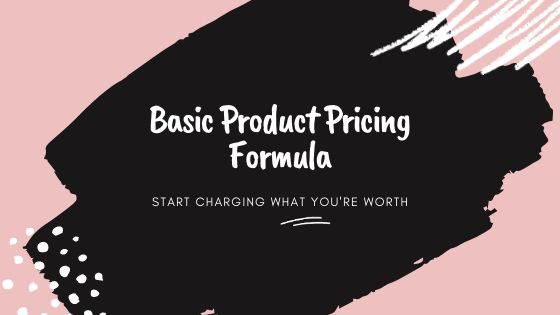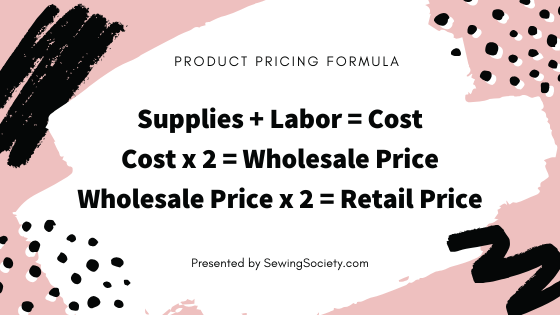Disclosure: This post may contain affiliate links. I earn a small commission when you click a link and make a purchase. Thanks for supporting SewingSociety.com!
Do you have a system for tracking your time, supplies, and overhead costs? These are all factors to consider when pricing your products. I’ve seen way too many crafters that are clueless about what to charge, and it hurts the whole handmade seller community. That’s why I want to share this guaranteed no stress formula to help you actually make money from your handmade products.
I understand that you love crafting and sewing. These are some of my hobbies, too… But, if you’re making things to sell, you really need to sit down and work out how to make a profit. If people are not paying what you deserve, you’ll eventually lose the joy in crafting and your handmade craft business will fail.
Basic Product Pricing Formula
Most people who sell handmade products follow the same pricing formula. I did not come up with it, but it works super well.
The retail price is what you should charge your customers, whether you plan to sell wholesale or not.
How to Calculate Your Labor Costs
The money you pay yourself or someone else to make your product is your labor cost. This is not the same thing as your profit (more on that later). To calculate your labor cost, you need to determine an hourly rate you’d like to make or pay someone to make your product. This should be above minimum wage.
After you’ve determined an hourly labor rate, you multiply it by the amount of time it takes you to create something. For example, if your skills are worth $20 per hour and it takes you 30 minutes to create something, your labor cost is $10 for that item.
You have put a lot of time and effort into developing your making skills, whether that is sewing, painting, crocheting, or anything else. These are skills many people do not have and you should be compensated fairly for that. The better your skills, the more money you should charge for labor. This is really important. Do not undervalue your skill!
Read This: If You Want to Make Money from the Things You Sew, Start Charging What You’re Worth!
How to Calculate Your Supply Costs
Your cost of supplies is the total amount of money you must spend to create your product. It includes all materials, listing fees, shipping costs, and any other expenses you encounter. Be sure to factor in overheads like electricity, shopping time, travel, branding, packaging, etc. If you don’t think you can set a value for each of these overheads, tack on an additional 10-20% for each item.
How to Markup Your Handmade Products to Make a Profit
After you know the cost of labor and the cost of supplies, you simply add them together to determine your overall cost of making a product. However, this is not the amount of money you charge your customers. You still need to mark items up to make a profit. There are two markups: wholesale and retail.
Here’s a quick look at the pricing formula again:
Supplies + Labor = Cost
Cost x 2 = Wholesale Price
Wholesale Price x 2 = Retail Price
To set the wholesale price of your handmade products, you multiply your product cost by two. Then, to set the retail price, you multiple by two again. This is the amount of money you charge customers. It doesn’t matter if you are selling on Etsy, your own website, or at a craft fair, you should charge customers the retail price.
Some businesses markup their products much more. This is not something you should do when starting out in your handmade business, but as the perceived value and demand for your products increases, you can increase your markups considerably.
You’re not going to make much money if you sell your items at cost. Sure, you might make a decent hourly wage if you’re the one making all the products yourself, but this doesn’t give you any room to grow your business. That’s why you need to markup your products for wholesale and retail.
Now, I know what you’re thinking…
If you markup your products, nobody will buy them.
This is not true! There are customers that value the time and skill it requires to make something by hand. They are willing to pay for this quality. The people who are looking for a bargain should not be your target customers. Let them shop at retail stores that mass produce cheap quality products. When customers are ready for quality, they’ll come looking for you.
The reason why you need to markup your products is to make a profit. Your profits are used to pay business fees, such as website hosting, education, taxes, legal advice, automation tools, and new supplies. Your profit is not your income. Profit goes back into your business.
Income is money that goes to your bank account. After deducting all business expenses, the leftover money is your income. You should have a separate bank account for your business expenses.
If a celebrity or influencer wants to help you sell your products, they need to be compensated, which is why you create a wholesale price. It still leaves you room to make a profit.
Even if you don’t plan to ever sell your products at wholesale, you should still do the second markup. It’s hard to predict where your business will take you a few years from now and it’s better to account for growth from the beginning.
Make sure to bookmark this page so you have quick access to the pricing formula. You should use this formula for pricing handmade jewelry, bags, clothing, and anything else you make to sell.
Are you still overwhelmed at the idea of pricing your handmade products? You can invest in software to make the process even easier. Craftybase and Craft Maker Pro are two options. Both help with inventory and bookkeeping for your handmade business.
Share this post on Pinterest!









3 Comments on “Guaranteed No Stress Formula for Pricing Handmade Products”